Featured Articles
- 01 What Is NTFS File System
- 02 What Is exFAT Format
- 03 What Is FAT File System Format (FAT, FAT16, FAT32)
- 04 What Is EXT2/3/4 File System (Linux) Format
- 05 NTFS VS exFAT VS FAT32, What's the Difference
- 06 How to Change File System to NTFS, FAT32, EXT
- 07 How to Convert File System - NTFS to FAT32
- 08 Best FAT32 Converter Free Download
- 09 Troubleshoot File System Errors
- 10 Fix File Is Too Large for Destination File System
- 11 Fix Volume Does Not Contain A Recognized File System
This page aims at providing you with a clear clue about what is the file system format and which file system is the best for different usages. With a handy file system conversion tool, you can also seamlessly change the file system format to NTFS, FAT32, exFAT, or EXT2/3/4. So stay calm if the computer warns that a file system error was found on your drive, and you may follow the solutions here to get rid of typical file system errors like an expert.
Are you ready? Let's get started here.
In this article, you'll learn:
- What Is File System
- File System Format: NTFS, FAT32, exFAT, or EXT2/3/4, Which Should I Use
- How to Change File System Format Between NTFS, FAT32, exFAT, and EXT2/3/4
- File System Error Troubleshooting - Full Solutions
What Is File System
Definition of File System:
According to Wikipedia, it could be defined that the file system is a structure that the operating system applies to manage data in groups via logic rules.
Why Is File System Important
The file system helps the operating system to manage data and files in a logical way. With it, users can easily access, secure, read, write, and modify data on their storage devices.
Instead, without the file system, data on a drive will be stored disorderly, taking huge storage devices and making it difficult for users to access and find desired files. The file system also makes lost files easy to be retrieved.
What's The Relationship Between File System and Operating System
If you want to understand the relationship between the file system and operating system, it's essential to learn:
How the file system works
A file system indexes all the data information on a storage device, including the size of the File, attributes, location, and hierarchy in the directory. The file system also specifies the path to a file via the structure of directories with a format.
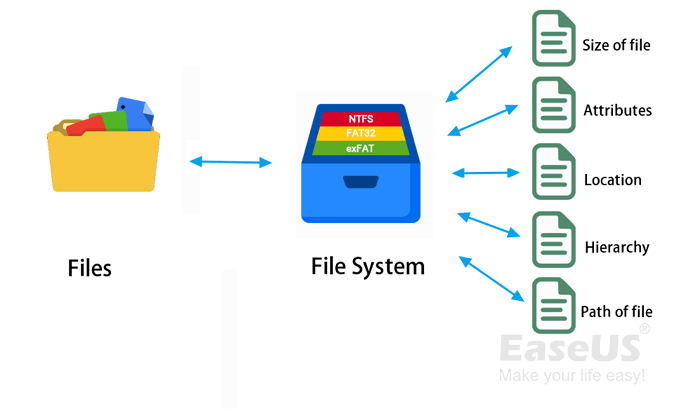
Structure of file system metadata
All the data information of files on a storage drive is stored in the file system metadata:
- Date created
- Date modified
- Last date of access
- Last backup
- User ID of the file creator
- Access permissions
- File size
How the operating system access file system
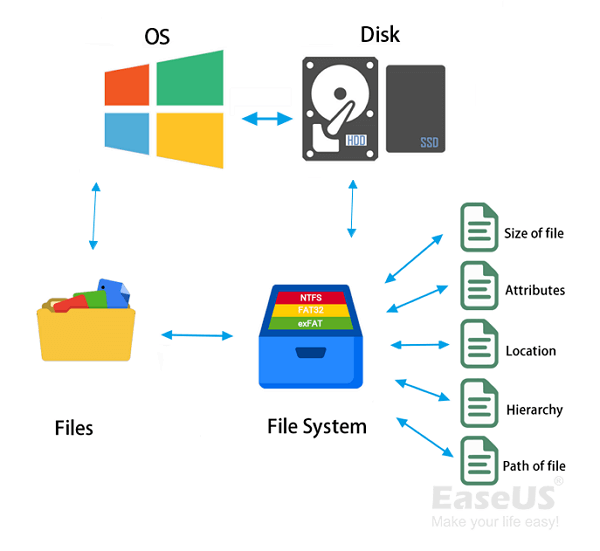
Here is how the operating system uses the file system to process and access files on a storage device:
- You create a partition on a hard drive or external drive.
- You add a file system format to the drive.
- You store a file in a folder, a directory, or a subdirectory on the drive.
- The file system record the location information of these files.
- OS uses the file system to store and locate these files on your storage devices.
Check the image here, and you'll get the relationship between the file system and OS:
Types of File System Format
When it comes to learning the types of file systems, there are more than 10 types of file systems. They are disk file systems, flash file systems, tape file systems, database file systems, transactional file systems, network file systems, shared-disk file systems, special file systems, minimal file systems, and flat file systems.
They all are not like the ones you already know, right? When we mention the NTFS, FAT32, or HFS file system, we are talking about the file system format of disk drives. You can also take it as disk file system formats.
Here is a list of popular file system formats that are used on Windows, Mac, and Linux operating systems:
- Windows File System - FAT, NTFS, exFAT
- macOS - HFS, APFS, HFS+
- Linux - EXT2/3/4, XFS, JFS, Btrfs
File System Format: NTFS, FAT32, exFAT, or EXT2/3/4, Which Should I Use
So what is the best file system format on Windows? NTFS, FAT32, exFAT, or EXT? Which should I use? We'll thoroughly discuss these 3 questions here in this part. So follow and get to learn when to use the correct file system format on your drive now.
What Is NTFS, FAT32, exFAT, and EXT2/3/4 File System
First, let's get a basic idea about NTFS, FAT32, exFAT, and EXT2/3/4.
1. NTFS File System
The NTFS file system is regarded as the default file system format in Windows operating systems, and it surpassed the FAT file system in some ways. Check the list below and learn more about it:
- Initial Release: 1993
- Developer: Tom Miller, Gary Kimura, Brain Andrew, and David Goebel.
- Last Version: V3.1, (Commonly called NTFS 5.1)
NTFS File System Structure:
The NTFS file system has 5 components: O Boot Record, MFT1, MFT Metadata, MFT2, and Data Area.
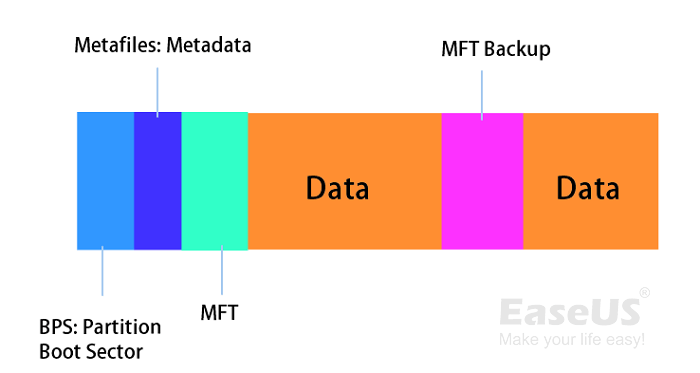
Learn More About NTFS:
Follow this link: What Is NTFS File System, Do I Need It, and learn more details about the NTFS file system format.
2. FAT or FAT32
FAT, also known as File Allocation Table, is a file system developed for personal computers. Originally developed in 1977 for use on floppy disks, it was adapted for use on hard disks and other devices. It is often supported for compatibility reasons by current operating systems for personal computers and many mobile devices and embedded systems, allowing the interchange of data between disparate systems. - by Wikipedia
According to Wikipedia, FAT32, a successor of FAT16, was designed by Microsoft as a new file system version. FAT32 supports an increased number of possible clusters and reuses most of the existing codes. This file system overcomes the volume size limit of FAT16 and allows DOS real-mode code to handle the format.
- Initial Release: 1977
- Developer: Microsoft, NCR, IBM, Caldera, and more.
- Last Version: FAT32
FAT File System Structure:
The FAT file system consists of four major components: Reserved sectors, FAT Region, Root Directory Region, and Data Region.
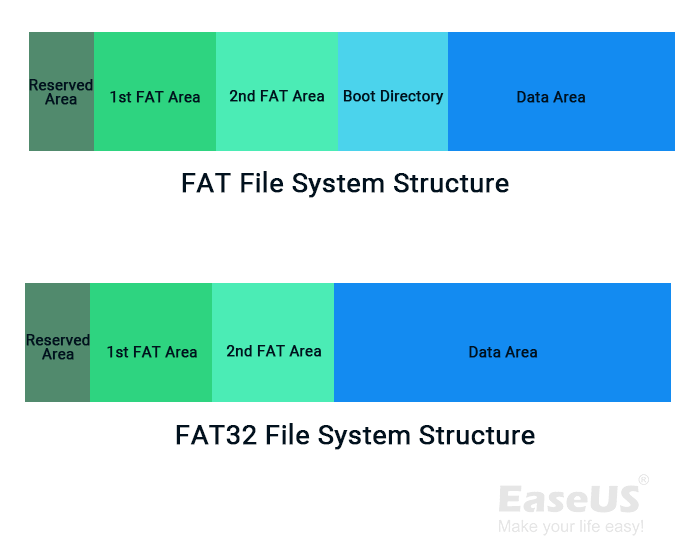
3. exFAT File System
According to Wikipedia, it's clear that the exFAT file system is a new format that is primarily designed for removable storage devices, like USB flash drives, SD cards, etc.
- Initial Release: 2006
- Developer: Microsoft
- Last Version: exFAT
exFAT File System Structure:
The exFAT file system consists of 4 main sections: the Main Boot Region, Backup Boot Region, FAT Region, and Data Region.
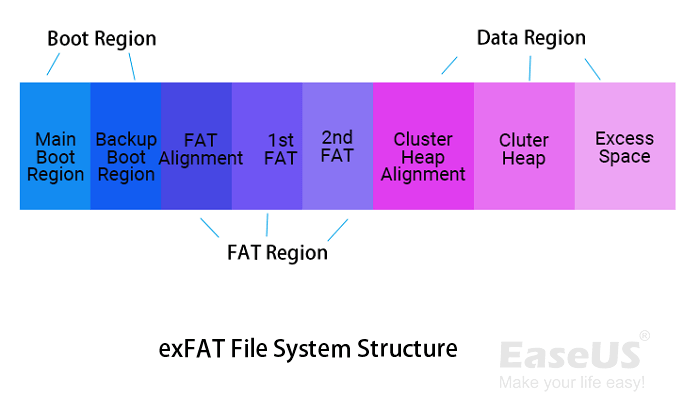
Learn More About exFAT:
What is the exFAT file system designed for? Click here to learn about What Is exFat Format: Everything You Need to Know.
4. EXT File System - EXT2/3/4
According to Wikipedia, it's clear that the EXT file system is a Linux format that takes the place of the MINIX file system.
- Initial Release: 1992
- Developer: Remy Card
- Last Version: EXT4
EXT File System Structure:
The EXT file system can be divided into one block and two groups, including the Boot Block, Block Group 0 (which contains Super Block, Group Descriptors, Data Block Bitmap, Inode Bitmap, Inode Table, and Data Blocks), and Block Group n.
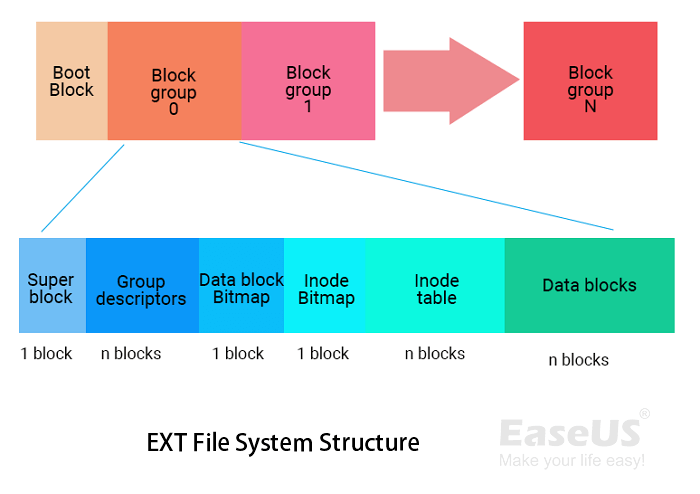
NTFS VS FAT32 VS exFAT VS EXT2/3/4, What's The Difference
So what's the difference between NTFS, FAT32, exFAT, and EXT/2/3/4 file systems? The biggest difference is that these file system formats are designed for different circumstances and purposes.
Comparison: NTFS VS FAT32, FAT32 VS exFAT, exFAT VS EXT2/3/4
Here we compared NTFS, FAT32, exFAT, and EXT2/3/4 and listed all differences here in this table. Check the differences here now:
| Differences | Max File Size | Max Volume Size | Operating System |
|---|---|---|---|
| NTFS |
|
|
|
| FAT32 |
|
|
|
| exFAT |
|
|
|
| EXT2/3/4 |
|
|
|
According to this table, it's clear that different operating systems respectively support each file system. Also, the maximum file size and maximum volume size are different.
If you are wondering about more differences between these file systems, click the links here to get more details: NTFS vs. exFAT vs. FAT32, NTFS or FAT32, Best File System for USB
Which File System Should I Use, NTFS, FAT32, exFAT, or EXT?
So when do I use NTFS, exFAT, or FAT32? We compared these file system formats together and came out with the listed suggestions for you.
Here is when to use the right file system:
On Windows -
- NTFS - Set for the OS or data drive, huge file storage or transfer (bigger than 4GB), or use it on a gaming disk.
- Fat32 - Set for external gaming drive, Android memory card, small-capacity USB or SD card (32GB or smaller).
- exFAT - Super huge file storage (8K videos) for a big external hard drive (64GB or bigger)
On macOS -
- APFS - macOS 10.13-10.15, external SSD
- HFS+ - Mac OS X (pre-2-16), Time Machine backup, Mechanical hard drive
- Extend File Allocation Table (exFAT) - Use both on Mac and Windows, external hard drive
- MS-DOS (FAT32) - USB flash drive, save individual files less than 4GB on USB.
On Linux-
- EXT4 is regarded as the best Linux file system for now.
Tutorial: How to Change File System Format Between NTFS, FAT32, exFAT, and EXT2/3/4
When you have already known which file system can satisfy your need the most, how will you change the file system format? And in what way can you efficiently change the file system format on your drive or external storage devices? This is what we are about to discuss here.
2 Ways to Change File System Format on Disk:
- #1. Format to Change File System Format to NTFS, FAT32, exFAT or EXT2/3/4
- #2. Convert File System to NTFS/FAT32 with Third-Party Conversion Tool
So when to format or convert the file system? Both formatting and converting methods can assist normal users to switch the file system format on a storage device or an internal disk on your computer.
But when to use the formatting method and when to use the conversion tool? Check the tips here:
#1. Format Drive to Change File System Between NTFS, FAT32, exFAT, and EXT2/3/4
- Benefit: Directly change the file system format by formatting a drive.
- Drawback: Formatting will remove all existing data on a storage device.
- Applies to: new hard drive, or used data disks/USB, or SD card that you don't have essential files on it.
- Tools: Windows Explorer, Disk Management.
Note: Formatting a drive to a new file system format will remove all existing data, so make sure that you back up all essentials on your disk to another secure location first.
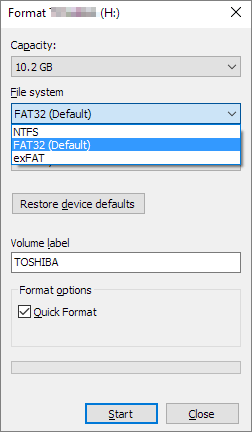
Step-By-Step Guide
Need a detailed guide? Click here to learn about how to change the file system to NTFS, FAT32, or EXT2/3 on your drives, USBs, and SD cards.
#2. Convert File System to NTFS/FAT32 with a Thrid-Party File System Conversion Tool
- Benefit: Easy to use, no data loss, no formatting.
- Drawback: Only support converting NTFS to FAT32 and FAT32 to NTFS.
- Applies to: switch the file system on an important data drive without losing any data.
- Tools: Third-party file system conversion tool or FAT32 converter tool.
For a seamlessly easy way to convert file system format, EaseUS Partition Master with its Convert feature can help. It enables you directly switch the file system format between NTFS and FAT32 without losing any data. This software even supports you changing the file system to a Linux format - EXT2/3/4.
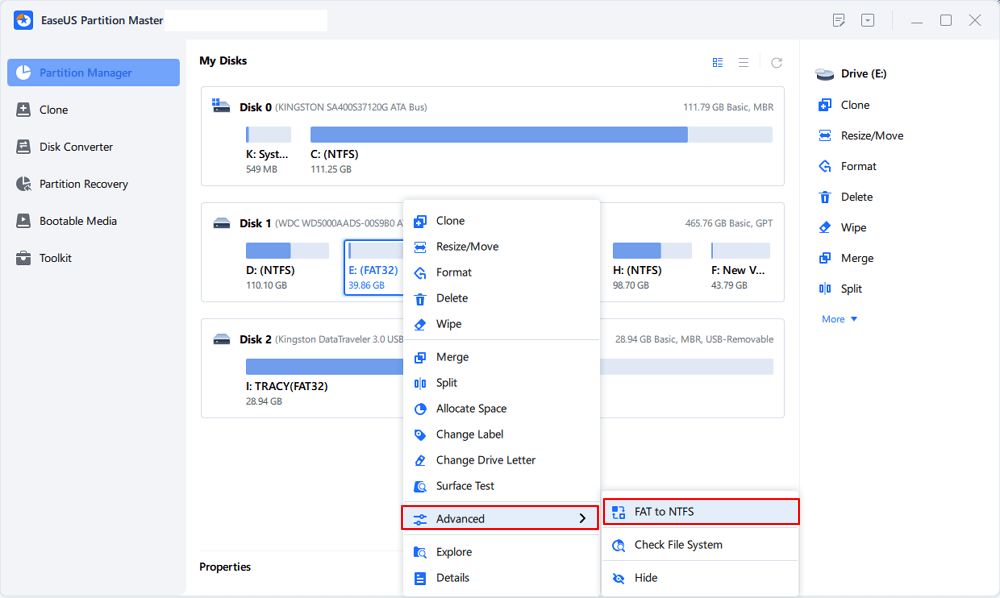
Step-By-Step Guide
Still, wondering how to switch file systems on your disk? Click here to learn how to convert NTFS to FAT32 or exFAT to NTFS on your own in Windows.
All you need is to follow these operational processes to complete changing the file system format on your disk. Then, you'll get a desired file system format on your storage devices to start a new task by then.
File System Error Troubleshooting - Full Solutions
Changing file system formats on a storage device or Windows computers are easy with the provided methods above. However, what if your computer hard drive or external storage devices contain unknown file system errors and are invalid for executing some specific operations? What can you do?
Here is what you can learn and get here. First, learn the file system error symptoms, and get an efficient solution to fix it immediately.
Symptoms of File System Error
It doesn't matter that you have no idea about what caused your drive malfunction. You can check the following symptoms, and with one or even two errors on your disk, you'll need a solution to fix the file system error to make the drive work again:
- NTFS file system error - BSOD, boot loop, etc.
- RAW file system error
- Stop code file system
- The file is too large for the destination file system
- Volume does not contain a recognized file system
- The device or disk becomes inaccessible
- The device is not showing up in File Explorer, but the Disk Management
What Caused File System Error?
Plenty of factors could cause the file system error on your drive, for instance:
- Virus, malware, spyware infection
- Sudden power failure or unstable power supply
- Interruption of the file transfer
- Bad sectors
- Unplug the device improperly, more.
Troubleshooting File System Errors - Full Solutions
So how do I fix these file system errors on my drives? Follow the fixes here:
#1. Restore Data First If Your Drive Is Still Detectable
In case you lose some essential files on the problematic drive, it's highly recommended that you take a reliable third-party data recovery software to scan and restore all existing data first.
EaseUS Data Recovery Wizard is one of the tools that you can rely on.
#2. Run File System Checker - Check and Fix File System Errors Immediately
The Windows operating system has a built-in check disk tool named ScanDisk, and you can simply run it to scan your disk and fix existing file system errors on your drive:
- Press Windows + E to open File Explorer.
- Right-click the problematic drive and select "Properties".
- Go to the Tools tab and click "Check" below the Error-checking section.
- Click "Scan drive" and let this tool scan and fix all found errors.
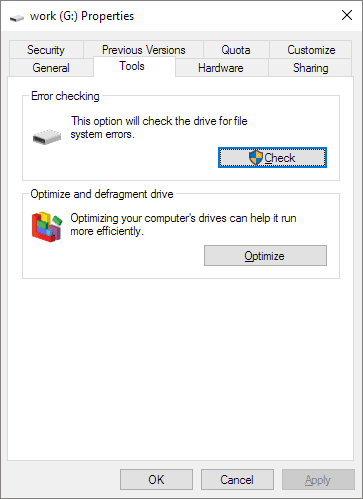
#3. Advanced Troubleshooting Solutions Toward Complex File System Errors
Note that the causes of file system errors are complex, and so do the fixes. If your disk is with some complex file system errors, check the fixes below, and see if you can get an instant solution here:
- File System Is RAW - Convert RAW to NTFS With or Without Formatting
- File Is Too Large for Destination File System on USB/External Hard Drive
- Windows Has Detected File System Corruption on Local Disk
- The Volume Does Not Contain A Recognized File System
- The Type of the File System Is RAW; CHKDSK Is Not Available
Hint: If the provided solutions don't work for your problem, hit yourself by using the Search feature on the EaseUS website or contact our support team by emailing [email protected] for help.
Conclusion
On this page, we give you a thorough idea about what is file system formats and the most popular file system formats on Windows, Mac, and Linux.
To sum up, it doesn't matter if you don't know which file system is best. You can directly refer to the list here and set the correct file system for your device:
- FAT32 - 32GB or smaller USB/SD card, used on Windows and, Mac, Android phones.
- NTFS - Windows disk partitions, transfer 4GB+ big files, gaming disk.
- exFAT - 64GB or bigger external hard drive or USB drives, used on Windows and Mac.
- EXT4 - Create a Linux partition for a specific environment.
- APFS - Latest macOS operating system disk.
There are multiple ways to change file systems to NTFS, FAT32, exFAT, or EXT, including File Explorer, Disk Management, and even CMD. However, for the easiest disk format conversion tool, they are not on the top of the list.
A third-party disk conversion tool - EaseUS Partition Master is always at your side. It's easy, user-friendly, and secure for some file system format conversion tasks.
Was This Page Helpful?
Updated by Tracy King
Tracy became a member of the EaseUS content team in 2013. Being a technical writer for over 10 years, she is enthusiastic about sharing tips to assist readers in resolving complex issues in disk management, file transfer, PC & Mac performance optimization, etc., like an expert.
Related Articles
-
A Starter Guide to the Windows Disk Management
![author icon]() Tracy King/Dec 23, 2025
Tracy King/Dec 23, 2025 -
Disk Partition: How to Partition A Hard Drive You Must Know in 2024
![author icon]() Tracy King/Dec 23, 2025
Tracy King/Dec 23, 2025 -
What Is UEFI and How Do I Use It on Windows? [Full Guide]
![author icon]() Tracy King/Dec 23, 2025
Tracy King/Dec 23, 2025 -
What Does Check Disk Actually Do and How to Run Check Disk (CHKDSK) in Windows [Beginners' Guide]
![author icon]() Tracy King/Dec 23, 2025
Tracy King/Dec 23, 2025